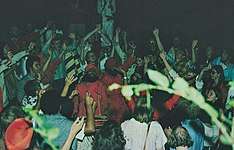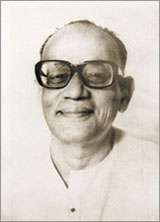Ananda Marga
Ánanda Márga "The Path of Bliss", also spelled Anand Marg and Ananda Marg) or officially Ánanda Márga Pracáraka Saḿgha (organization for the propagation of the path of bliss), is a world-wide socio-spiritual organisation and movement founded in Jamalpur, Bihar, India in 1955 by Prabhat Ranjan Sarkar. It is also the name of the philosophy and life-style propounded by Sarkar, described as a practical philosophy for personal development and the all-around transformation of the society.
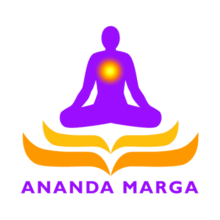 | |
| Abbreviation | AMPS |
|---|---|
| Motto | Átmamokśárthaḿ jagaddhitáya ca (Self-Realisation and Service to the Universe) |
| Formation | 1 January 1955 |
| Founder | Prabhat Ranjan Sarkar |
| Type | Socio-Spiritual organization |
| Legal status | Foundation |
| Purpose | Educational, Philanthropic, Philosophic studies, Spirituality |
| Headquarters | Ánandanagar, Purulia, West Bengal, India |
| Location |
|
Area served | Worldwide |
Official language | English, Sanskrit, Bengali, Hindi |
Head | Purodhá Pramukha |
Main organ | Central Purodhá Board |
| Website | www anandamarga21 ampsnys |
| Part of a series on | |
| Hindu philosophy | |
|---|---|
 | |
| Orthodox | |
|
|
|
| Heterodox | |
|
|
|
|
|
|
History
Prabhat Ranjan Sarkar founded the Ánanda Márga Pracáraka Saḿgha (more commonly known as "Ananda Marga" or, less frequently, "Ananda Marg" or "Anand Marg") on 5 January 1955. The literal translation into English is "the Organization to Propagate the Path of Bliss." The stated aims of the organization are "liberation of self and service to humanity".[1] In March of the same year, the first group of acharyas was created in Jamalpur.
Sarkar's incarceration
During the 1960s, the organisation expanded rapidly in India, sending Acharyas as missionaries to other continents. Ananda Marga's popularity in India put it in direct confrontation with the Communist Party in West Bengal. In 1967, Ananda Marga headquarters came under attack by locals who were allegedly incited by Communist leaders.[2] Criticism of corruption in the Indian government by acharyas of Ananda Marga also put it in confrontation with Prime Minister Indira Gandhi. In 1971, Sarkar was imprisoned in India for the alleged murder of Ananda Marga members. In February 1973, Sarkar was poisoned in prison, allegedly by the jail doctor on orders from the higher echelons of government. On 1 April, after recovering his health, Sarkar began fasting in support of a demand for an inquest into his poisoning. That demand was never met. So he continued his fast for the next five years, four months, and two days, until 2 August 1978 when he was released from jail after having been acquitted of all charges.
Sydney Hilton bombing
The Sydney Hilton Hotel bombing occurred on 13 February 1978, when a bomb exploded outside the Hilton Hotel in Sydney, New South Wales, Australia. At the time the hotel was the site of the first Commonwealth Heads of Government Regional Meeting (CHOGRM), a regional offshoot of the biennial meetings of the heads of government from across the Commonwealth of Nations. In June 1978, members of the Ananda Marga organisation were implicated by a police informant, Richard John Seary, but his evidence has been discredited. A member of Ananda Marga, Evan Pederick, claimed in 1989 that he had carried out the Hilton bombing on the orders of another member, Tim Anderson. Both men were given prison sentences, but Anderson was acquitted on appeal in 1991.[3] Pederick appealed but his appeal failed and he served eight years in prison.
Bijon Setu massacre
On the morning of 30 April 1982, 17 Ananda Marga renunciates (16 monks and one nun) were dragged out of taxis that were taking them to an educational conference at their headquarters in Tiljala, Kolkata. They were beaten to death and then set on fire simultaneously at three different locations. It was reported that the killings took place in broad daylight and were witnessed by thousands of people, as they were performed in public.[4]
Mahaprayan of Sarkar
P.R. Sarkar died on 21 October 1990. Acarya Shraddhananda Avadhuta was elected from the body of purodhas as President of Ananda Marga Pracharaka Samgha global organization and Purodha Pramukha.[note 1]
Violence towards Ananda Marga Monks
On 18 September 2003, Acarya Abhipremananda Avadhuta was killed and many others were permanently injured in a fight between two Ananda Marga groups. Control of the head office of Ananda Marga was believed to be the main motive. The two groups, one from the prominent Bengal province and the other from the rest of India, had been in rivalry.
In 1975, two followers of Ananda Marga, Santosh Anand Avdhoot and Sudevanand Avdhoot, were convicted of a failed attempt to attack Chief Justice of India A. N. Ray; they were sentenced to seven years in jail.[5]
L.N. Mishra, then railway minister of India, was attacked by Ananad Marga monks and followers in 1975. The bombing killed Mishra. Santoshanand and Sudevanand were convicted of the crime.
The Purulia arms drop happened on 17 December 1995 when unauthorised arms were dropped from an Antonov An-26 aircraft in Purulia district in the state of West Bengal in India.[6][7] While the true motive is shrouded in mystery and conjecture, the BBC, after its investigation into it, alleged that arms were intended for the socio-spiritual organization Ananda Marga.[8] This has been disputed by the prime accused in the case, Kim Davy, who claims the central government itself was behind the arms drop to disrupt harmony and exterminate the CPI(M) supporters.[9][10]
Disciplines, Teachings and Practice
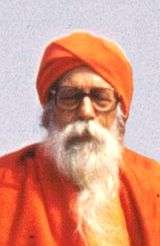
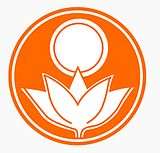
Tantra yoga, as interpreted by Shrii Shrii Anandamurti, is the practical philosophy which serves as foundation of Ananda Marga. According to P.R. Sarkar's teachings Tantra means liberation from darkness, the root tan meaning darkness, and tra liberation.
Meditation is the main spiritual practice of this tantric tradition, and through it the practitioner struggles to overcome weaknesses and imperfections. The basis of Ananda Marga practice is covered by a set of rules called the 'Sixteen Points' that guide the practitioner on both spiritual and social aspects.
Anandamurti expounded these principles in Ānanda Sūtram a text composed in Sanskrit in 1961.
Meditation, Lalita Marmika dance and Kirtan

In the tantric tradition of Ananda Marga the spiritual aspirant (sadhaka) practices sadhana. Sadhana (a Sanskrit word) signifies the effort through which a person becomes completely realized. In Tantra the spiritual master, the guru,[note 2] plays a special role. The guru guides and leads students on the spiritual path. The aspirant learns meditation by a qualified acarya. An acarya is most commonly a monk or nun, but in the Ananda Marga tradition there are also "family acaryas". In the initiation the aspirant makes a commitment to practice meditation and to live in harmony with the universal balance, and is then taught the technique itself. The aspirant is then required to keep the individual lessons personal. In addition, he also taught Kapalika meditation to many sanyásins. His system of yoga can be termed as Rájadhirája Yoga, Tantra Yoga, or simply Ánanda Márga Yoga. The basic Ánanda Márga meditation system is called Sahaja Yoga ('simple yoga'). The sahaja system consists of 6 meditation techniques or lessons taught one by one, on a personal basis.[note 3] There is also a set of higher meditation lessons taught to advanced practitioners committed to dedicate more time for spiritual practices and universal service.
According to the Ananda Marga system the Lalita Marmika dance is performed, particularly during the collective meditation.[note 4] This yogic dance with swaying movements, combined with a kirtan (the chanting of the universal mantra), is regarded as useful in freeing the mind and preparing it for meditation.
Ananda Marga system recommends to its members the practice of collective meditation at least once a week. These meetings called Dharma Chakras (weekly held in a place called Dhyan Mandir) are preceded by the singing of few Prabhat Samgiita ("Songs of the New Dawn" composed by the Ananda Marga founder) followed by the spiritual dance of Lalita Marmika along with the singing of and by the practice of meditation. Before meditation the ![]()
![]()
![]()
Vegetarian diet, yogic asanas, physical exercises and yogic treatments
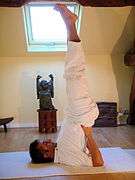
The basic practices of Ananda Marga consist of yoga asanas, mudras, bandhas, pranayama, self-massage and two specific dances, kaos'ikii and tandava. Lacto-vegetarian diet and fasting are also included, as a fundamental part of yogic practice.
- Diet and fasting: Lacto-vegetarian diet of Ananda Marga avoids meat, fish, eggs and some substances which are claimed to have a negative effect on the mind, particularly if "mucus-producing." Moreover, on specific monthly dates called Ekadashi (Sanskrit: একাদশী, ekādaśī: is the eleventh day after the full moon or after the new moon),[note 5] the regular practice of Upavasa (yoga fasting) is recommended to improve health and strengthen the mind.
- Yoga asanas, mudras and bandhas: comprises 42 asanas[note 6] which were chosen by Sarkar. There are mainly two types of asana: svasthyasanas and dhyanasanas.[12] They should be performed at least once a day. 15 Yoga mudras and bandhas are also part of the basic Ananda Marga yoga.[note 7]
- Yogic treatments: in 1957 Sarkar published in Bengali Yaogika Cikitsa o Dravyaguna, which was translated into English and published in 1983, with revisions under the title Yogic Treatments and Natural Remedies. In this handbook, he gave indications on yogic treatments using ásanas and mudrás combined with claims about natural and traditional remedies for about forty diseases. The book also contains many tips for maintaining good health through the use of water, clay, etc.[note 8]
- Kaoshikii: the 'dance for mental expansion', was defined by Sarkar a 'physico-psycho-spiritual dance,' performed by all, and consists of 18 mudras aligning with 6 physical postures, each associated with a specific idea[note 9] while strengthening body and mind and making them flexible.
- Tandava or Tāṇḍava: is a vigorous dance.[note 10] The name tandava is derived from the Sanskrit word tandu, which means 'to jump'. This dance is only performed by male followers in Ananda Marga. The dance is performed to imbue the practitioner's mind with courage and honour, dispelling all sorts of complexes and fear, even fear of death itself.[note 11][13]
Spiritual and Social Philosophy
The philosophy of Ananda Marga is a synthetic outlook, recognizing a theistic singularity or 'Supreme Consciousness',[14] which is claimed to be both transcendental and manifested in all.[note 12] It covers both the spiritual and the social combining the two in a unique synthesis of universal vision.[note 13] To this end Ananda Marga suggests a practical, rational, and systematic way of life for the balanced development of all human potentialities: physical, psychic and spiritual. This system incorporate practices that range from hygiene and diet, yoga postures, to a scientific technique of meditation based on moral rules and directed to the inner fulfillment. It recognizes that a balance is needed between the spiritual and mundane aspects of existence, and that neither one should be neglected at the expense of the other. Hence, the goal of Ananda Marga is "self-realization and the welfare of all".
Spiritual philosophy
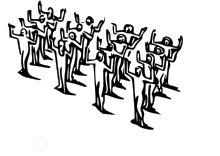
The spiritual philosophy of Ananda Marga covers a vast range of topics and can be learned from P.R. Sarkar's publications. Ananda Marga philosophy recognizes that the universe is the creation of the mental thought waves of the 'Supreme consciousness'. The following is a brief list of the essential elements of Ananda Marga Spiritual Philosophy:
- Atma or Soul and Paramatma or the Cosmic Consciousness: the Consciousness (Purusa) is reflected in the unit objects forming the "unit consciousness" (atma) or soul. Particularly the reflection of the soul on the mind is called jiivatma and in that case the "reflector-soul" is called Paramatma (Supreme Soul).[note 14]
| Yama (Restraint) | |
|---|---|
| Ahim'sa' (Benignity) | Thinking, speaking, and acting without inflicting pain or harm on another |
| Satya (Benevolence) | Thinking and speaking with goodwill |
| Asteya (Honesty) | Not taking or keeping what belongs to others |
| Brahmacarya (Ideation) | Constant mental association with the Supreme |
| Aparigraha (Frugality) | Non-indulgence in superfluous amenities |
| Niyama (Regulation) | |
| Shaoca (Cleanliness) | Physical and mental purity, both internal and external |
| Santos'a (Contentment) | Maintaining a state of mental ease |
| Tapah (Sacrifice) | Acceptance of sufferings to reach the spiritual goal |
| Sva'dhya'ya (Contemplation) | Clear understanding of any spiritual subject |
| Iishvara Pran'idha'na (Dedication) | Adopting the Cosmic Controller as the only ideal of life and moving with ever-accelerating speed toward that Desideratum |
| Intent is primary, but both intent and action should conform if possible. | |
- Realms of the Mind: according to Ananda Marga philosophy the human mind is composed of five layers called Kosas:[note 15] 1)Kamamaya Kosa ("desire layer") or "Crude Mind": is the crudest layer, purified through adherence to the yogic code of morality, Yama-Niyama.[note 16] 2)Manomaya Kosa ("layer of thinking") or "Subtle Mind": is the layer of thought and memory.[note 17] 3)Atimanasa Kosa or "Supramental Mind": is the intuitive layer.[note 18] 4)Vijinanamaya Kosa ("layer of the special knowledge") or "Subliminal Mind": is the layer of conscience or discrimination (viveka) and vaeragya (non-attachment).[note 19] 5)Hiranyamaya Kosa ("golden level") or "Subtle Causal Mind": is the subtlest layer. Here the awareness of mind is very close to the direct experience of "Supreme Consciousness".[note 20]
- Microvita theory: Microvita is plural for Micro-vitum and literally means "micro-life". The concept was first introduced in 1986 through a series of lectures by P.R. Sarkar. According to this notion, microvita are entities which come within the realms both of physicality of psychic expression. They are smaller and subtler than physical atoms and subatomic particles. So far as physicality is concerned, the position of these microvita is just between ectoplasm and electron, but they are neither ectoplasm nor electron.[15] The author predicted that they would be recognized by conventional science when it is developed much further.
Social philosophy
The social outlook of Ananda Marga recognizes that the welfare of the individual is linked with the welfare of the collective, each relying on the other for its existence and dynamism. According to this philosophy everyone has the right to equal opportunities of life and development and as such there should be no discrimination on the basis of superficial barriers such as race, nationality and religion. Ananda Marga advocates a world of justice, security and peace for all.[16] The Social Philosophy of Ananda Marga can be categorized under the topics:
- Neohumanism: in 1982, Sarkar extended his writings on the subject of human society with the introduction of his new theory of "Neohumanism".[17] While humanism extends the recognition of equal rights to all humans, yet tends to anthropocentric worldview, neohumanism, according to Sarkar's theory, is instead the elevation of humanism to universalism, thus expanding an inclusive spirit of welfare to all living beings and the created world.[note 21]
- Education: according to the Ananda Marga system "Education is for Liberation." Education means the simultaneous development in the physical, mental and spiritual realms of human existence. By this, dormant human potentialities will be awakened and put to proper use. Sarkar said that real education leads to a pervasive sense of love and compassion for all creation; in the Ananda Marga's education system, special emphasis is given to moral education and the inculcation of idealism together with a "psycho-pedagogical approach" and a blending of occidental extroversional science and oriental introversional philosophy.[note 22]
- Culture: In his discourse "Talks on Prout", given in Ranchi in July 1961, Sarkar makes a distinction between the terms "culture" and "customs". According to Sarkar "culture... is the collective name for different expressions of life..." but "...all of society has the same culture. There are local variations in the mode or state of cultural expression, but the expression is universal... These local variations are called customs... Thus local modes of expression bearing local or group specialities are customs, but the expression itself is culture. Therefore it is a mistake to readjust boundaries on the basis of language and culture. Indian culture and the culture of the world are one and the same."[18] The philosophy of Sarkar reinterprets the general concept of culture by inserting it into a new universalistic outlook. As described by Antonello Maggipinto:
...If the term "culture" is usually referred to the original meaning of this word (i.e. from the Greek "paidéia" to the Latin "humanitas", that is to human beings capable of distinguishably mastering the arts, rhetoric, and philosophy), then Sarkar offers a new point of view, with a large universalistic explanation: “the culture of the whole human race is one, but marked by different local manifestations... it is the same, but varying in expression." (Sarkar, P.R., 1987)...[19]
- PROUT ("Progressive Utilization Theory"): is a socio-economic theory first mentioned in 1959 by P. R. Sarkar[20] in his speech "The Cosmic Brotherood".[21] In 1968, Sarkar founded the organization "Proutist Block of India" (PBI), to further the ideals of his theory through political and social action.[22]
Tantra in Ananda Marga
Shrii Shrii Anandamurti´s "Tantra and its Effect on Society", 1959.[23]
Sarkar weaves continuity with the ancient philosophy of Tantra, infusing new insights in human psychology, social theory and in each individuals' roles as spiritual and "socio-economic-cultural-political" beings. Ánanda Márga Tantra has a broad metaphysical base which allows for ways of knowing, feeling and processing which go far beyond intellectuality or limited rationality. Priorities are given to the spiritual development, as Shrii Shrii Ánandamúrti notes, "spiritual life controls all other arenas of human life."[24]Ananda Marga Tantra is a principle, a science which if practiced will lead to the desired objective. The essence of Tantra is to awaken the latent spiritual force in the human personality and unify oneself with the Cosmic Consciousness.[note 23]
Guru and Disciple
According to tantric tradition a proper preceptor and a proper disciple are both essential for success on the path of Tantra. P.R. Sarkar clearly explains[25] that, disciples are of three categories: 1) disciples that acquire spiritual knowledge when they are in close contact with the preceptor, but as soon as they are apart from him they forget all his/her teachings, 2) disciples that learn many things from the preceptor with great hardship, but do not take proper care to preserve those instructions. They lose their hard-earned knowledge out of negligence, 3) disciples that carefully preserve deep in their minds and hearts whatever they have learned from their preceptor by wisely putting those teachings into practice. This is the best category of disciples.
References
Footnotes
- He served in that capacity until his death in 2008.
- Who is the guru? In Ananda Sutram, on sutra 3–9, P. R. Sarkar as Shri Shri Anandamurti clearly stated Brahmaeva gururekah náparah: Only Brahma is the guru, no one else. Who is Brahma is explained in the first sutra (1–1): Shivashaktyátmakam Brahma: Brahma is the composite of Shiva and Shakti
- This is the short list of six lessons: 1)First Lesson: Iishvara Pranidhana (Personal mantra and Ishta Cakra), 2)Second Lesson: Guru Mantra (Personal Guru Mantra), 3)Third Lesson: Tattva Dharana (Concentration on Cakras' Tattvas), 4)Fourth Lesson: Sadharana Pranayama (Basic Pranayama. A special respiration technique), 5)Fifth Lesson: Cakra Shodhana (Purification of Cakras. A special type of Dharana), 6)Sixth Lesson: Guru Dhyana (Special type of ideation for Dhyana).
- According with the teachings of P.R. Sarkar, Lalita Marmika is a devotional dance invented by Parvati, the wife of Shiva.
- Ananda Marga acharyas practice fasting in two additional days per month called Purnima and Amavasya
- The following are the Ananda Marga asanasas listed from P.R. Sarkar in "Ananda Marga Caryacarya part 3": Sarvanungasana, Matsyamudra, Matsyasana, Matsyendrasana, Virasana, Cakrasana, Naokasana (or Dhanurasana), Utkata Pascimottanasana, Parvatasana (or Halasana), Shivasana, Vajrasana, Siddhasana, Baddha Padmasana, Kukkutasana, Gomukhasana, Mayurasana, Kurmakasana, Sahaja Utkatasana, Shalabhasana, Bhujaungasana, Shashaungasana, Bhastrikasana, Janusirsasana, Ardhashivasana, Ardhakurmakasana (or Dirgha Pranama), Yogasana (or Yogamudra), Tuladandasana, Ustrasana, Utkata Kurmakasana, Jatila Utkatasana, Utkata Vajrasana, Padahastasana, Shivasana, Padmasana, Karmasana, Jinanasana, Bhavasana, Granthimuktasana, Garudasana, Dvisamakonasana, Tejasana, Mandukasana.
- Mudras and bandhas are also listed in "Ananda Marga Caryacarya part 3": Uddayana Mudra, Bandhatraya Yoga (Mahamudra, Mahabandha, Mahaveda), Parthivii Mudra, Ambhasii Mudra, Agneyii Mudra, Vayavii Mudra, Akashii Mudra, Manasii Mudra, Agnisara Mudra, Kakacaincu Mudra, Trimunda Mudra, Ashvinii Mudra, Vajrolii Mudra.
- In the preface the author specifically warns the reader not to risk of practising ásanas and mudrás without the guidance of an experienced yoga teacher.
- The spiritual ideation is carried along with the dance in order to establish a subtle link with the divine.
- Associated with Shiva in his cosmic dancer image of Nataraja.
- Thus the dance also has an associated ideation. The dancer starts off with the two arms outstretched, the left arm with an open palm, and the right arm with a clenched fist. The dancer ideates holding a human skull in the left hand, symbolizing death, and ideates on holding a knife in the right, symbolizing the fight for life. The actual objects (human skull and knife) may be also used. The dance starts with a jump, landing with bent knees. Another jump follows, and the dance continues in a jumping manner, lifting one leg then the other continuously. Tribuneindia.com story
- This universe, having been created by the 'Supreme Consciousness', is existing in the 'Supreme Entity': "The 'Supreme Entity' is the vastest entity; the ultimate source of all cosmic emanations. The 'Supreme Entity', which is difficult to conceive, is the subtlest of the subtle. He is farther away than any other entity, but again He is nearer than the nearest. Only the one who looks into the innermost recesses of himself can realize the 'Supreme Entity'." (Shrii Shrii Anandamurti)
- In his famous discourse "Sambhúti and Mahásambhúti" given in July 1967, Delhi, India during the DMC (Dharma Maha Chakra) P.R. Sarkar well explained this concept: "In short, whatever was created in the past is the original creation (sambhúti) of God. The sum total of all creations is the Cosmic Order (Brahmáńd́a). This includes the sun as well as the small ant which crawls on the earth. Whether it is a dead star or a living star, whether it is a nebula or a Milky Way or a galaxy – all belong to one universal family."
- Vis’aya purus’a'vabha’shah jiiva’tma’: "The reflection of Consciousness – Purusa – in the unit object is known as jiiva’tma – "unit soul" – (A’nanda Sutram, Chapter 2, Sutra 8 (2–8) in Avadhūtika Ānanda Mitra Ācāryā, 1981).
- The last three deeper layers are collectively called "Causal Mind". "Causal" signifies that these layers are in the most direct contact with the "Causal Consciousness" from which the mind has evolved and within which it exists.
- This Kosa controls the various autonomic activities of the body and the expression of the mental propensities, known as vrtti, in Samskrta.
- This Kosa gives experience of pleasure and pain. It is developed naturally through physical clash, and in Ananda Marga sadhana by pranayama with cosmic ideation.
- This Kosa gives the capacity of intuitive dreams, clairvoyance, telepathy and creative insight. It is developed naturally through psychic clash, and in Ananda Marga sadhana by methods of pratyahara (withdrawal) such as shuddhis and Guru Puja.
- This Kosa is developed naturally through psychic clash, and its development is accelerated by the process of dharana.
- Here there is only the separation of a thin veil of ignorance. This Kosa is developed naturally through the attraction for the Great, and dhyana accelerates this process for sadhakas (spirituals aspirants).
- "When the underlying spirit of humanism is extended to everything, animate and inanimate, in this universe – I have designated this as "Neohumanism". This Neohumanism will elevate humanism to universalism, the cult of love for all created beings of this universe." (Sarkar, P. R., 1982).
- "The noblest form of social service is to educate the public and create a sense of consciousness in them. This sense of consciousness is to be instilled in every human being. This is your duty. The goal of education is to elevate the all-round standard, and especially the intellectual standard. In addition, the elevation of the moral standard is extremely necessary in the sphere of education. This moral standard is deficient today. It is lacking in the present educational system also. You are to create a new social order. Therefore, you should first acquire more and more knowledge in different spheres of life and also you are to upgrade your morality. Along with your intellectual standard, if you have morality, then everybody will respect you. Try to acquire as much knowledge as possible through our own books. Education which leads to the acquisition of knowledge plus morality makes for a peaceful society." (Sarkar, P. R., Discourses on Neo– humanist Education.).
- "It is not a religion or empty philosophy which can be confined to the realms of abstract speculation or theoretical debate. Tantra is a process of subjective transformation, which may be practiced by anyone irrespective of gender, cultural background, education, social status or intellectual evolution, as an adequate system of spiritual endeavor is the birthright of all. Tantra does not discriminate by any racial, genealogical, political, national or economic differences amongst human beings, as the later might form the basis for one human group to assert superiority over another. Tantra does, however, give recognition to individual vigor and the development of latent human potentialities, which make some people outstand in their lives. Consequently Tantra puts greater emphasis on human values than on social values".(Coyle, G. 1985).
Citations
- Dharmavedananda 1999, p. 13 to 23.
- Lewis 2011, p. 254.
- John Tognolini, 1991, Green Left Weekly, "Archived copy". Archived from the original on 5 February 2017. Retrieved 10 June 2017.CS1 maint: archived copy as title (link)
- Namboodiri, Udayan (2 May 1997). "Basu Govt still suppressing facts on Margi massacre". The Indian Express. Archived from the original on 12 March 2010. Retrieved 17 March 2014.
- Iqbal, Mohammed (16 August 2014). "High Court upholds conviction of two persons in former CJI attack case". The Hindu. ISSN 0971-751X. Archived from the original on 22 June 2020. Retrieved 30 June 2020.
- "Purulia Expose: India's best kept secret".
- "Purulia arms drop case resurfaces with new set of revelations".
- "Alleged gun runner's conspiracy claims". BBC Online. 23 July 1998. Retrieved 13 March 2013.
- "Purulia Expose: India's best kept secret". The Times of India. 28 April 2011. Retrieved 13 March 2013.
- "Purulia arms drop: Niels Holck aka Kim Davy tells his story". Hindustan Times.
- "What is Baba Nam Kevalam? - Definition from Yogapedia". Yogapedia.com. Retrieved 18 April 2020.
- Shrii Shrii Anandamurti, 2010, p.20.
- "Religion and Law Consortium: A Research Forum for Legal Developments on International Law and Religion or Belief Topics". Religlaw.org. Retrieved 18 March 2011.
- See: Shrii Shrii Ánandamúrti, 1954, pp. 15 and 68.
- Dalal 2011, p. 325.
- Ananda Marga Social Philosophy
- See: Sarkar, P. R., 1982.
- Sarkar 1968.
- Maggipinto 2000.
- Craig, Edward, ed. (1998). Routledge Encyclopedia of Philosophy: Sociology of knowledge to Zaroastrianism. Routledge (Taylor & Francis). ISBN 0-415-16916-X.
- Later published in Sarkar, P. R. (1961-2001) p. 89-97.
- Fukui 1985, p. 357.
- Anandamurti 1959.
- Bussey, Marcus. Homo Tantricus: Tantra as an Episteme for Future Generations
- See: Shrii Shrii Anandamurti, 1982 and 1994.
Sources
- Anandamurti, Shrii Shrii (1959), Tantra and its Effect on Society, Bhagalpur: Ananda Marga Pubs
- Dalal, Roshen (23 November 2011), The Religions of India: A Concise Guide to Nine Major Faiths, Penguin Books India, ISBN 978-0-14-341517-6CS1 maint: ref=harv (link)
- Dharmavedananda, Ác. (1999), Travel with the Mystic Master, Singapore: Ananda Marga Publications, ISBN 981-04-0864-1
- Fukui, Haruhiro (1985), Political Parties of Asia and the Pacific, Greenwood Press, p. 357, ISBN 0-313-21350-XCS1 maint: ref=harv (link)
- Lewis, James R. (2011), Violence and New Religious Movements, Oxford University Press, ISBN 978-0-19-973563-1
- Maggipinto, Antonello (2000), "Multilanguage Acquisition, New Technologies, Education and Global Citizenship", in American Association for Italian Studies (ed.), Academic journal article from Italian Culture, 18–2, New York: AAIS, p. 147
- Sarkar, Prabhat Ranjan (1968), PROUT in a Nutshell Part 15, Ananda Marga Publications
Further reading
- Ananda Marga Aa. Vv. (1973). Teaching asanas: An Ananda Marga manual for teacher (2nd ed.). Los Altos Hills: Ananda Marga Publications. ISBN 0-88476-000-6.
- Acarya Prasiidananda Avadhuta (1990). Neo-Humanist Ecology. Ananda Marga Publications. ISBN 971-8623-12-4.
- Avadhūtika Ānanda Mitra Ācāryā (1986). Neo-humanist Education: Education for a New World. Ananda Marga Publications. ISBN 0-88476-007-3.
- Anandamurti, Shrii Shrii (1995). Ananda Marga Caryacarya, part 1 (6th ed.). Ananda Marga Publications. ISBN 81-7252-028-X.
- Anandamurti, Shrii Shrii (1987). Ananda Marga Caryacarya, part 2 (4th ed.). Ananda Marga Publications.
- Anandamurti, Shrii Shrii (1992). Ananda Marga Caryacarya, part 3 (4th ed.). Ananda Marga Publications. ISBN 81-7252-154-5.
- Anandamurti, Shrii Shrii (1961). Ánanda Sútram. Jamalpur: Ananda Marga Pubs. ISBN 8172520271.
- Nandita, & Devadatta. (1971). Path of bliss: Ananda Marga yoga. Wichita, Kansas: Ananda Marga Publishers.
- Hatley, Shaman and Inayatullah, Sohail. (1999), "Karma Samnyasa: Sarkar’s reconceptualization of Indian ascetism", in K. Ishwaran, ed., Ascetic culture: renunciation and worldly engagement (Leiden, Brill, Vol. 73, International Studies in Sociology and Social Anthropology),139–152
- Inayatullah, Sohail. (2002) Understanding Sarkar: The Indian Episteme, Macrohistory and Transformative Knowledge. Leiden: Brill.
- Tarak. (1990). Ananda Marga, social and spiritual practices. Calcutta: Ananda Marga Publications.
- Anandamurti, Shrii Shrii. (1988). Ananda Marga ideology and way of life in a nutshell. Calcutta: Ānanda Mārga Pracāraka Saṁgha.
- Sarkar, Prabhat Rainjan (1957–1968). Problems of the Day. Jamalpur: Ananda Marga Pubs. ISBN 81-7252-019-0.
- Sarkar, Prabhat Rainjan (Ac. Pranavnanda Avt. Editor) (1961–2001). Idea and Ideology. Kolkata: Ananda Marga Publications. ISBN 81-7252-205-3.
- Sarkar, Prabhat Rainjan (1983) [1957 first ed. in Bengali]. Yogic Treatments and Natural Remedies (first English ed.). Jamalpur/Calcutta: Ananda Marga Publications. ISBN 81-7252-178-2.
- Sarkar, Prabhat Rainjan (1982). The Liberation of Intellect: Neohumanism. Kolkata: Ananda Marga Publications. ISBN 81-7252-168-5.
- Sarkar, Prabhat Rainjan (1987). Neohumanism in a Nutshell, vol. 1. Kolkata: Ananda Marga Publications. ISBN 81-7252-184-7.
- Sarkar, Prabhat Rainjan (1987). Neohumanism in a Nutshell, vol. 2. Kolkata: Ananda Marga Publications. ISBN 81-7252-184-7.

